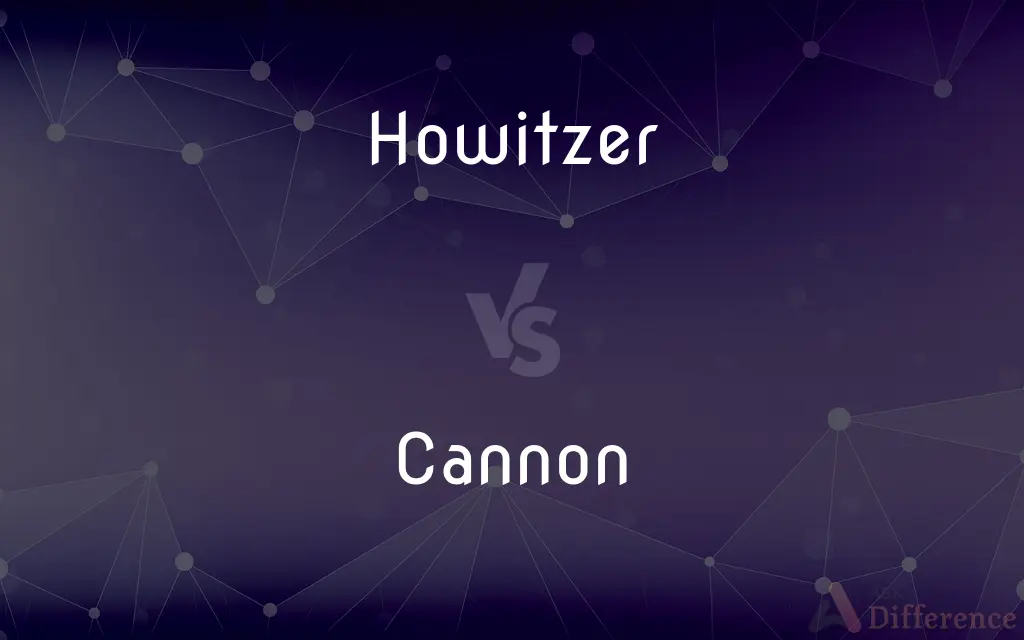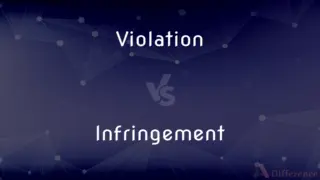Howitzer vs. Cannon — What's the Difference?
By Tayyaba Rehman & Urooj Arif — Updated on March 27, 2024
A howitzer is designed for high-angle fire with a relatively short barrel, while a cannon is a broader term for large-caliber firearms with varied firing capabilities.

Difference Between Howitzer and Cannon
Table of Contents
ADVERTISEMENT
Key Differences
Howitzers are artillery pieces characterized by their ability to fire projectiles on high trajectories, enabling them to hit targets obscured by obstacles. They are designed for both direct and indirect fire, typically featuring barrels shorter than those of traditional cannons. On the other hand, cannons encompass a wide range of large-caliber artillery, including howitzers, but are generally associated with direct fire and longer barrels for greater range and accuracy.
The primary function of howitzers is to deliver explosive shells, smoke, or illumination rounds over obstacles such as hills or fortifications, making them ideal for supporting infantry in varied terrains. Whereas cannons have historically been used in roles ranging from field artillery to coastal and siege warfare, emphasizing their versatility in both offensive and defensive positions.
Howitzers distinguish themselves through their mobility and ability to be deployed quickly in tactical situations. They are often mounted on tracked or wheeled vehicles for rapid positioning on the battlefield. Conversely, cannons, especially older models, were more static, requiring significant effort to move and position due to their weight and size.
Modern howitzers are equipped with sophisticated aiming and firing systems, allowing for precision targeting over extended ranges. This contrasts with the broader category of cannons, where precision and range capabilities can vary widely depending on the specific type and era of the artillery piece.
Despite their differences, both howitzers and cannons play crucial roles in modern and historical warfare, providing essential support to ground forces and contributing significantly to the outcome of battles through their destructive firepower.
ADVERTISEMENT
Comparison Chart
Trajectory
High-angle fire capable.
Varied, generally lower-angle.
Barrel Length
Relatively short.
Longer, varies with type.
Role
Indirect fire, lobbing shells over obstacles.
Direct and indirect fire, versatile use.
Mobility
Often mobile, mounted on vehicles.
Varies, older versions less mobile.
Modern Equipments
Equipped with advanced aiming systems for precision.
Precision and equipment vary widely.
Compare with Definitions
Howitzer
A type of artillery piece designed for high-trajectory fire.
The howitzer is effective in hitting targets behind cover, using its curved firing path.
Cannon
A large-caliber gun classified primarily for direct fire with a variety of uses.
Cannons have been a mainstay in warfare, capable of delivering devastating volleys against fortifications and enemy lines.
Howitzer
Ideal for indirect fire roles, such as lobbing shells into enemy fortifications.
During the battle, the howitzers were used to deliver explosive rounds over the mountain onto the enemy base.
Cannon
Versatile, used in sieges, field battles, and as naval armaments.
The cannon's power was demonstrated in the siege, where its shots breached the city walls.
Howitzer
Uses a shorter barrel for high-angle firing.
The howitzer's design, with its shorter barrel, allows for the high-arc shots needed in indirect fire situations.
Cannon
A symbol of military strength and technological advancement over centuries.
The development of the cannon significantly altered medieval warfare, making castle walls vulnerable to artillery.
Howitzer
Has evolved to meet the demands of modern warfare, retaining relevance through technological advancements.
Modern howitzers incorporate GPS and computer targeting systems, enhancing their accuracy and effectiveness.
Cannon
Traditionally less mobile, requiring setup and support equipment.
Moving the heavy cannon into position required a team of soldiers and horses.
Howitzer
Often mounted on mobile platforms for rapid deployment.
The army's new howitzer can be quickly moved and set up for fire in diverse terrains.
Cannon
Equipped with a longer barrel for direct fire and greater range.
The cannon's long barrel allowed it to fire projectiles directly at targets several miles away.
Howitzer
A howitzer () is a long-ranged weapon, falling between a cannon (also known as artillery gun in the U.S.), which fires shells at flat trajectories, and a mortar, which fires at high angles of ascent and descent. Howitzers, like other artillery equipment, are usually organized in a group called a battery.
Cannon
A cannon is a large-caliber gun classified as a type of artillery, and usually launches a projectile using explosive chemical propellant. Gunpowder ("black powder") was the primary propellant before the invention of smokeless powder during the late 19th century.
Howitzer
A relatively short cannon that delivers shells at a medium muzzle velocity, usually by a high trajectory.
Cannon
A large, heavy piece of artillery, typically mounted on wheels, formerly used in warfare
They would cross at the Town ford, under cover of the defending cannon
Howitzer
A cannon that combines certain characteristics of field guns and mortars, delivering projectiles with medium velocities, usually with relatively high trajectories; normally a cannon with a tube length of 20 to 30 calibers.
Cannon
A stroke in which the cue ball strikes two balls successively.
Howitzer
A powerfully hit shot.
Cannon
A heavy cylinder or hollow drum that is able to rotate independently on a shaft.
Howitzer
To attack with a howitzer.
Cannon
Collide with something forcefully or at an angle
His shot cannoned off the crossbar
The couple behind almost cannoned into us
Howitzer
A gun so short that the projectile, which was hollow, could be put in its place by hand; a kind of mortar.
Cannon
Make a cannon shot.
Howitzer
A muzzle-loading high-angle gun with a short barrel that fires shells at high elevations for a short range
Cannon
A weapon, typically mounted, that fires heavy projectiles from a cylindrical barrel. Cannons include guns, howitzers, and mortars.
Cannon
The loop at the top of a bell by which it is hung.
Cannon
A round bit for a horse.
Cannon
(Zoology) The section of the lower leg in some hoofed mammals between the hock or knee and the fetlock, containing the cannon bone.
Cannon
Chiefly British A carom made in billiards.
Cannon
To bombard with cannon.
Cannon
Chiefly British To cause to carom in billiards.
Cannon
To fire cannon.
Cannon
Chiefly British To make a carom in billiards.
Cannon
A complete assembly, consisting of an artillery tube and a breech mechanism, firing mechanism or base cap, which is a component of a gun, howitzer or mortar. It may include muzzle appendages.
Cannon
Any similar device for shooting material out of a tube.
Water cannon
Glitter cannon
Cannon
An autocannon.
Cannon
A bone of a horse's leg, between the fetlock joint and the knee or hock.
Cannon
A cannon bit.
Cannon
(historical) A large muzzle-loading artillery piece.
Cannon
A carom.
In English billiards, a cannon is when one's cue ball strikes the other player's cue ball and the red ball on the same shot; and it is worth two points.
Cannon
The arm of a player who can throw well.
He's got a cannon out in right.
Cannon
(engineering) A hollow cylindrical piece carried by a revolving shaft, on which it may, however, revolve independently.
Cannon
(historical) A cylindrical item of plate armor protecting the arm, particularly one of a pair of such cylinders worn with a couter, the upper cannon protecting the upper arm and the lower cannon protecting the forearm.
Cannon
Alternative form of canon
Cannon
(Chinese chess) A piece which moves horizontally and vertically like a rook but captures another piece by jumping over a different piece in the line of attack.
Cannon
A pickpocket.
Cannon
To bombard with cannons.
Cannon
To play the carom billiard shot; to strike two balls with the cue ball.
The white cannoned off the red onto the pink.
Cannon
To fire something, especially spherical, rapidly.
Cannon
To collide or strike violently, especially so as to glance off or rebound.
Cannon
(fandom slang) canon
Cannon
A great gun; a piece of ordnance or artillery; a firearm for discharging heavy shot with great force.
Cannon
A hollow cylindrical piece carried by a revolving shaft, on which it may, however, revolve independently.
Cannon
A kind of type. See Canon.
Cannon
See Carom.
Cannon
To discharge cannon.
Cannon
To collide or strike violently, esp. so as to glance off or rebound; to strike and rebound.
He heard the right-hand goal post crack as a pony cannoned into it - crack, splinter, and fall like a mast.
Cannon
A large artillery gun that is usually on wheels
Cannon
Heavy gun fired from a tank
Cannon
(Middle Ages) a cylindrical piece of armor plate to protect the arm
Cannon
Heavy automatic gun fired from an airplane
Cannon
Lower part of the leg extending from the hock to the fetlock in hoofed mammals
Cannon
A shot in billiards in which the cue ball contacts one object ball and then the other
Cannon
Make a cannon
Cannon
Fire a cannon
Common Curiosities
What distinguishes a cannon?
A cannon is a broad term for large-caliber firearms, traditionally used for direct fire with a range of applications in warfare.
How do howitzers and cannons differ in use?
Howitzers are specialized for indirect fire roles, such as lobbing shells over terrain or obstacles, while cannons are versatile, used for both direct and indirect fire.
Are cannons obsolete?
While traditional cannons have evolved, the term "cannon" still encompasses modern artillery pieces, including howitzers, indicating they are not obsolete.
What role do howitzers play in modern warfare?
In modern warfare, howitzers provide critical support by delivering indirect fire against enemy positions, supporting infantry, and disrupting enemy movements.
What is the significance of barrel length in artillery?
Barrel length affects the projectile's velocity and trajectory, with longer barrels generally allowing for greater range and accuracy in direct fire situations.
Can howitzers be moved easily?
Modern howitzers are often mounted on mobile platforms, allowing for rapid deployment and repositioning on the battlefield.
How are cannons classified?
Cannons are classified based on caliber, barrel length, mobility, and the type of projectile they fire, among other characteristics.
What is a howitzer?
A howitzer is an artillery piece designed for high-trajectory fire, capable of hitting targets behind obstacles with explosive shells.
Do howitzers require specialized training to operate?
Operating a howitzer effectively requires specialized training in targeting, ballistics, and the handling of artillery systems.
How do environmental factors affect artillery fire?
Environmental factors like wind, temperature, and altitude can significantly affect the trajectory and range of artillery fire, necessitating adjustments by the crew.
What kind of projectiles do howitzers fire?
Howitzers fire a variety of projectiles, including explosive shells, smoke, and illumination rounds, depending on the mission requirements.
How has cannon design changed over the years?
Cannon design has evolved from simple muzzle-loaded guns to sophisticated, barrel-loaded artillery with advanced targeting systems, reflecting technological advancements.
Can howitzers be used against moving targets?
Modern howitzers, equipped with advanced targeting systems, can effectively engage moving targets, adjusting fire in real-time based on observed impacts.
What makes cannons effective in sieges?
Cannons are effective in sieges for their ability to breach fortifications with powerful, direct fire, disrupting enemy defenses and creating openings for assault.
Share Your Discovery

Previous Comparison
Sachet vs. Bag
Next Comparison
Violation vs. InfringementAuthor Spotlight
Written by
Tayyaba RehmanTayyaba Rehman is a distinguished writer, currently serving as a primary contributor to askdifference.com. As a researcher in semantics and etymology, Tayyaba's passion for the complexity of languages and their distinctions has found a perfect home on the platform. Tayyaba delves into the intricacies of language, distinguishing between commonly confused words and phrases, thereby providing clarity for readers worldwide.
Co-written by
Urooj ArifUrooj is a skilled content writer at Ask Difference, known for her exceptional ability to simplify complex topics into engaging and informative content. With a passion for research and a flair for clear, concise writing, she consistently delivers articles that resonate with our diverse audience.
















































